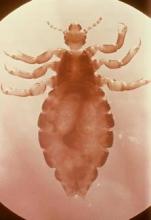WAILEA, HAWAII – With head lice showing increased rates of resistance to popular over-the-counter rinses, other alternatives are necessary, according to Dr. Albert C. Yan.
Two reasonably effective, nonpesticide, nonneurotoxic therapies that kill Pediculosis humanis capitis by asphyxiation are a prescription benzyl alcohol 5%/mineral oil product called Ulesfia lotion (Shionogi Pharma) and an OTC Cetaphil cleanser (Galderma) encasement technique, he said at the Hawaii Dermatology Seminar sponsored by Skin Disease Education Foundation (SDEF):
• Ulesfia lotion. The benzyl alcohol in Ulesfia lotion stuns the lice spiracles, or breathing holes, so they are frozen in the open position. The lice then drown in the mineral oil vehicle, explained Dr. Yan, a pediatric dermatologist at Children’s Hospital of Philadelphia.
Ulesfia lotion is approved for use in patients aged 6 months and older. It is applied for 10 minutes before being washed out. Because it is important to fully saturate the hair, the quantity of Ulesfia lotion used depends upon hair length. This is a nonovicidal therapy; retreatment is required 1 week later.
In two phase III trials, 127 Ulesfia-treated patients had cure rates of 86% and 97% a day after their second treatment, with no significant adverse events.
• Cetaphil gentle skin cleanser. The dry-on encasement technique involves application to the hair and scalp, a wait of 2 minutes, then a comb out. Eight hours later the hair is washed with regular shampoo. This procedure is repeated once weekly for 3 weeks. In two open studies totalling 133 patients, the cure rates were 95% and 97%.
Fomite management should be a component of either therapy. Clothes and bedding should be placed in a hot dryer for 10 minutes, and combs should either be run through the dishwasher or placed in isopropanol for 10 minutes.
Among the other alternative therapies Dr. Yan discussed were:
• Home remedies. Popular home remedies for head lice include mayonnaise, olive oil, butter, and vinegar. The Centers for Disease Control and Prevention has reported that there is no clear scientific evidence that any of these are effective. However, Dr. Yan noted that an in vitro study of lice and egg survival with home remedies found petrolatum to be the most effective, with 38% of lice remaining viable at 24 hours and just 6% of eggs hatching, compared with 98% of lice being viable and 56% of eggs hatching with olive oil, for example (J. Pediatr. Nurs. 2004;19:393-8).
• Malathion and spinosad. Rates of resistance to permethrin and pyrethrins now approach 50% in some areas. For resistant cases, in addition to the topical suffocants, Dr. Yan said he favors malathion (Ovide lotion, Taro Pharmaceuticals) and a new prescription product, spinosad 0.9% (Natroba, ParaPRO). However, malathion is indicated only for patients at least 6 years old, and spinosad is indicated only for those at least 4 years of age, whereas Ulesfia is indicated for children as young as age 6 months.
Malathion has good efficacy but a strong odor. Plus, it is flammable, so after applying it patients need to steer clear of the barbecue grill, cigarettes, and other flaming objects. Dr. Yan said he has patients leave it on for just 1-2 hours instead of overnight as labeled, because of data showing the briefer exposure period is equally effective.
Spinosad 0.9% received Food and Drug Administration marketing approval in January. This is a widely used crop pesticide that is both pediculicidal and ovicidal, yet has minimal mammalian toxicity. The topical suspension is left on for 10 minutes, then washed out with no need for combing in order to achieve efficacy.
Dr. Yan said he is a consultant to Topaz and has received research grants from Pierre Fabre and Promius Pharma. SDEF and this news organization are owned by Elsevier.


